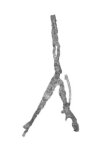From J. M. Rodwell 11 November 1871
Douglas House. | Highbury New Park. N.
Nov. 11. 1871
Dear Sir/
I scarcely like to trouble you with what may not be worth recording—but as at p. 63 of Vol. 1. of your Animals under domestication you mention having seen “two cases of distinct ⟨though⟩ slight forking” in the ass1—⟨I thin⟩k it worth while to mention that I noticed a most distinct bifurcation on the shoulders of a donkey, the property of a Clergyman at Dallington Sussex,2 which I saw this summer—in this fashion.

I also observed in the same animal five distinct (and one rather indistinct) circular zebra like markings on the legs. They were clearest on the fore legs.
The animal was of rather a dark grey.—
I am | dear Sir | with many thanks for your interesting Vol’s—all of which I have perused wi⟨th⟩ I think greatest interest | Yours faithfully | J M Rodwell
Footnotes
Bibliography
Post Office directory of the six home counties: Post Office directory of the six home counties, viz., Essex, Herts, Kent, Middlesex, Surrey and Sussex. London: W. Kelly & Co. 1845–78.
Variation: The variation of animals and plants under domestication. By Charles Darwin. 2 vols. London: John Murray. 1868.
Summary
Has read Variation and reports on markings on donkeys similar to those in vol. 1, p. 63.
Letter details
- Letter no.
- DCP-LETT-8063
- From
- John Medows Rodwell
- To
- Charles Robert Darwin
- Sent from
- Highbury New Park
- Source of text
- DAR 176: 189
- Physical description
- ALS 2pp
Please cite as
Darwin Correspondence Project, “Letter no. 8063,” accessed on 18 April 2024, https://www.darwinproject.ac.uk/letter/?docId=letters/DCP-LETT-8063.xml
Also published in The Correspondence of Charles Darwin, vol. 19


